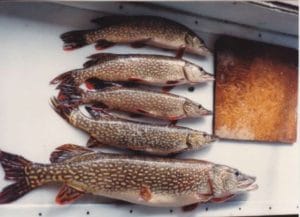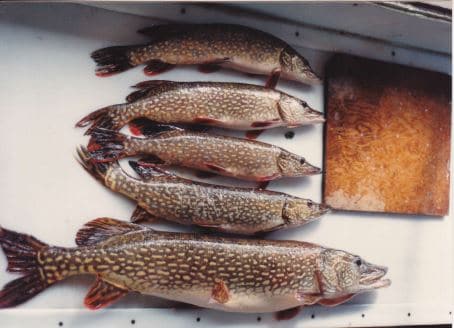
The first time I heard that people used other lures other than crankbaits when fishing for northern pike, I was actually confused. Why would anyone use anything other than crankbaits when they caught so many dang pike?
There’s no question that crankbaits are consistently some of the best lures around for pike fishing. Veteran anglers, guides, and professionals all have plenty of crankbaits close by from classic Rapalas, to Magnums and Bombers. Choosing the best crankbait for a specific situation relies on a lot, but northern pike love to hit crankbaits!
While everyone has their personal favorite fishing lures and styles, make no mistake about it: there’s a reason crankbaits dominate the list on our best northern pike lure review post. It’s because in our experience, and the experience of thousands of other anglers out there, nothing works as well or as consistently when it comes to getting the big pike to strike.
Pike tend to be very aggressive, very territorial, and they like to ambush their prey. This makes the crankbait an ideal lure when fishing for these predatory fish.
Does the Crankbait Color Matter for Pike?
Consistently over many decades of fishing for northern pike my dad, my brother, and I have always found that color matters quite a bit. While the best color changes based on body of water, clarity of water, and the weather (specifically how sunny it is vs. how cloudy), there are a few that we have often found success with.
Black & silver and blue & silver are our personal favorites. This goes for both regular sized crankbaits as well as the little bombers. With multiple rods in the boat there were always these two combinations on hand. In our case the blue & silver crankbaits were the first choice with the black and silver as a back up, but we never hesitated to trade one out for another.
The best alternative color for northern pike lures that we found once you got past the blue and black with silver combos was chartreuse. One interesting thing about chartreuse was it tended to be feast or famine. When nothing else was working but the chartreuse then those tended to send the pike into a feeding frenzy.
Some of our best pike fishing experiences and stringers took place because of these brightly colored lures. However, there were also many times these were a complete dud.
Once in a while an odd color would hit the mark. Perch did really well one time, while green with black side stripes didn’t work often, but sometimes when the algae count was high and neither blue nor black were working, that would occasionally absolutely knock things out of the park.
For some reason Dad once bought “rainbow trout” crankbaits that were ugly as sin. Those NEVER worked.
Most of our pike fishing was done in three different locations and these general rules of thumb remained consistent throughout. When it comes to type of lure – knowing when to use large crankbaits versus small ones, rattlers versus regulars, that was much harder to consistently predict although most of the time a regular crankbait would get something when pike fishing.
If in doubt start off with blue & silver and black & silver. We’d also recommend switching between regular crankbait sizes or small “bomber” crankbaits before moving to chartreuse, perch, or green striped. That has helped us maximize our pike fishing success over the decades.
What About Rattletraps or Blinking Light Crankbaits?
There are specialty crankbaits like rattlebaits, which can work extremely well after a storm when the waters are made dirtier and murkier than usual. The blinking light that comes with some crankbaits has also worked for others.
Full disclosure: our personal experience with using these is that generally the regular crankbaits are consistently more effective than rattletraps or especially blinking light crankbaits (in our experience these do the least well among the options).
The weather and clarity of water often have a lot to do with how these can be effective. Sometimes the additional stimulus plays on the pike’s nature as an aggressive predator and encourages them to strike while there are some bodies of water where the extra stimulus seemed to have the opposite effect and make the pike actually less likely to strike compared to other crankbaits being used out of the boat.
This was the case both with casting as well as trolling.
Why Are Crankbaits So Effective on Pike?
With most fish it’s undeniable that certain species have a bait or lure that tends to work better than others. While there are always exceptions, there’s a reason corn is used throughout many parts of the Midwest for trout, worms for panfish, and crankbaits for aggressive fish like bass and pike.
Basically almost any lure is there to mimic certain live bait or live prey, and fish are most likely to strike the lures that are most like the things the fish naturally feed on. Because pike love eating other fish (more than once we’ve caught and then released a pike that was smaller than the lure it hit), crankbaits are a great option.
Basically crankbaits are perfect for pike fishing because:
- The movement mimics local bait fish
- Anglers can vary speed to make them more attractive to pike
- The color and movement combination can trigger the ambush instinct
- The treble hooks increase your chance of hooking while a single hook will struggle to hold a pike
If you want to gear up before your next big fishing outing, aside from the earlier article we linked to on the best lures for catching northerns, we also have reviews on the best fishing rods for northern pike and the best nets for northern pike to make sure you’re fully prepared. Check them out!

